Child-Friendly Garden Design Guide
 Lee Burkhill: Award Winning Designer & BBC 1's Garden Rescue Presenters Official Blog
Lee Burkhill: Award Winning Designer & BBC 1's Garden Rescue Presenters Official Blog

Updated 2024: When it comes to garden design for children, you may have seen gardens simply turned into playgrounds with wood chips everywhere. There are ways to subtly design a garden that makes it exciting for children without completely removing the attraction for grown-ups!
Usually, people start by buying a massive set of play equipment and then try to shoehorn it into the garden. Resulting in it taking over and looking at odds with the rest of the garden design. However, there are far more subtle ways to create a garden that your children will love without sacrificing their own enjoyment.
This page contains affiliate links for products I use and love. If you take action (i.e. subscribe, make a purchase) after clicking a link, I may earn some gardening commission which helps me keep the Garden Ninja Blog free for all.
A child-friendly garden is a space that accommodates and encourages children to get outside and explore the space. Often child-friendly gardens feature play, sensory elements and planting to stimulate younger family members to get out into the garden. A child-friendly garden is not just a lawn or a play set stuffed into the corner of the garden!
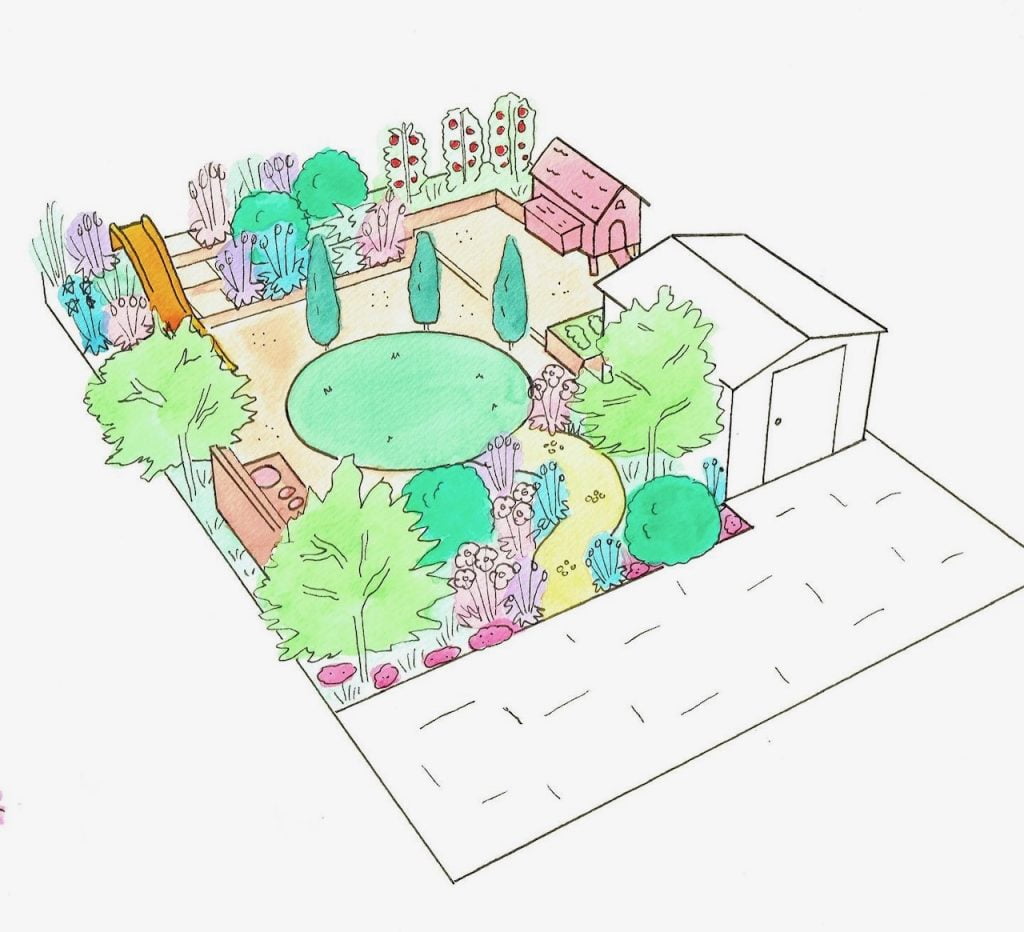
A child-friendly garden is a well-thought-out and multifunctional space which all ages can enjoy. If this type of garden is designed well, it shouldn't scream 'playground' and will look beautiful and be functional for the entire family. The example above shows how a carefully planted and designed garden can accommodate children's play as a seamless part of the overall design.
Can you spot the slide, mud kitchen and chicken coop above?
The first thing I do before starting any garden is to draw up a scaled plan or survey of the garden area. This can be as simple as measuring the perimeter and a few measurements across the midpoint of the garden to get an idea of size.
This then enables you to work out what will fit where and plan the layout of the garden
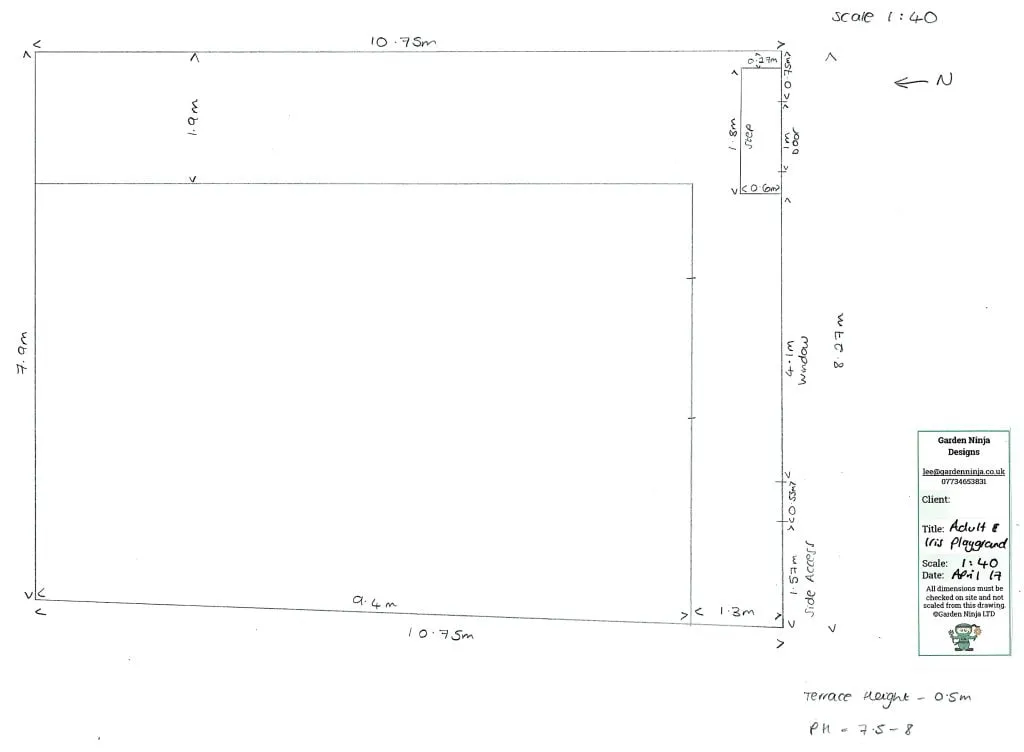
Garden zoning is a really good way to work out which parts of the garden are dedicated to which family members. Through zoning, you can work out which part of the garden gets the most sun for an adult sitting area and which part may be more shaded, perfect for a children's play area. You can read more on zones in a garden below.
Shaded areas are often better for children as it prevents them from becoming overexposed to the sun and these areas lend themselves better to blending in play equipment. It also adds that feeling of mystery for children, which can really help with active play.
The next step is where most people stop, as it involves some drawing. However, this is the most important part of child friendly garden design. By sketching out the zones, areas, and buildings (such as playhouses or sheds), you can start to work out how the different zones work together. You may even find that you have to reduce the zones at this stage as you have too many.
This is the ideal time to spot these design issues rather than when a builder turns up to start landscaping. Thats why this step is so important. It helps prevent mistakes and work out precisely what you and your children need in the garden.
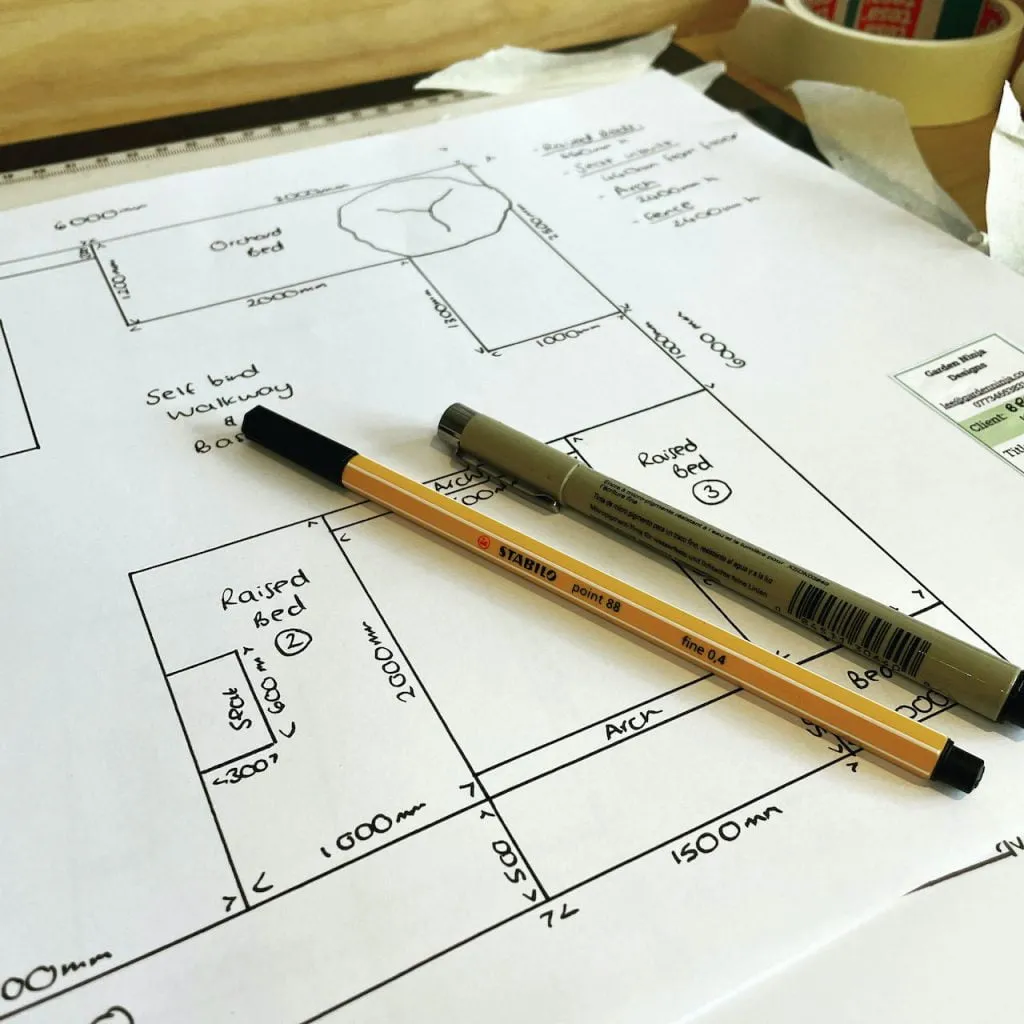
An excellent way to help connect the zones and bring some privacy is to use heights such as small garden trees or screens to provide different areas in the garden. By using these, you can make the garden feel much bigger and private whilst still keeping an eye on your children as they play. Meaning both children and adults feel like they have their own space and privacy.
Now it's time for the fun bit, adding the play areas to the garden! If you've got a specific play zone, it may be that you fill this area with various play obstacles, interactive items, swings or even a den. You could also interweave the play activities throughout the zones meaning the children can explore more. It really is up to you. See below how a teepee, climbing frame, and woodland path are all used for play while complementing the overall design.
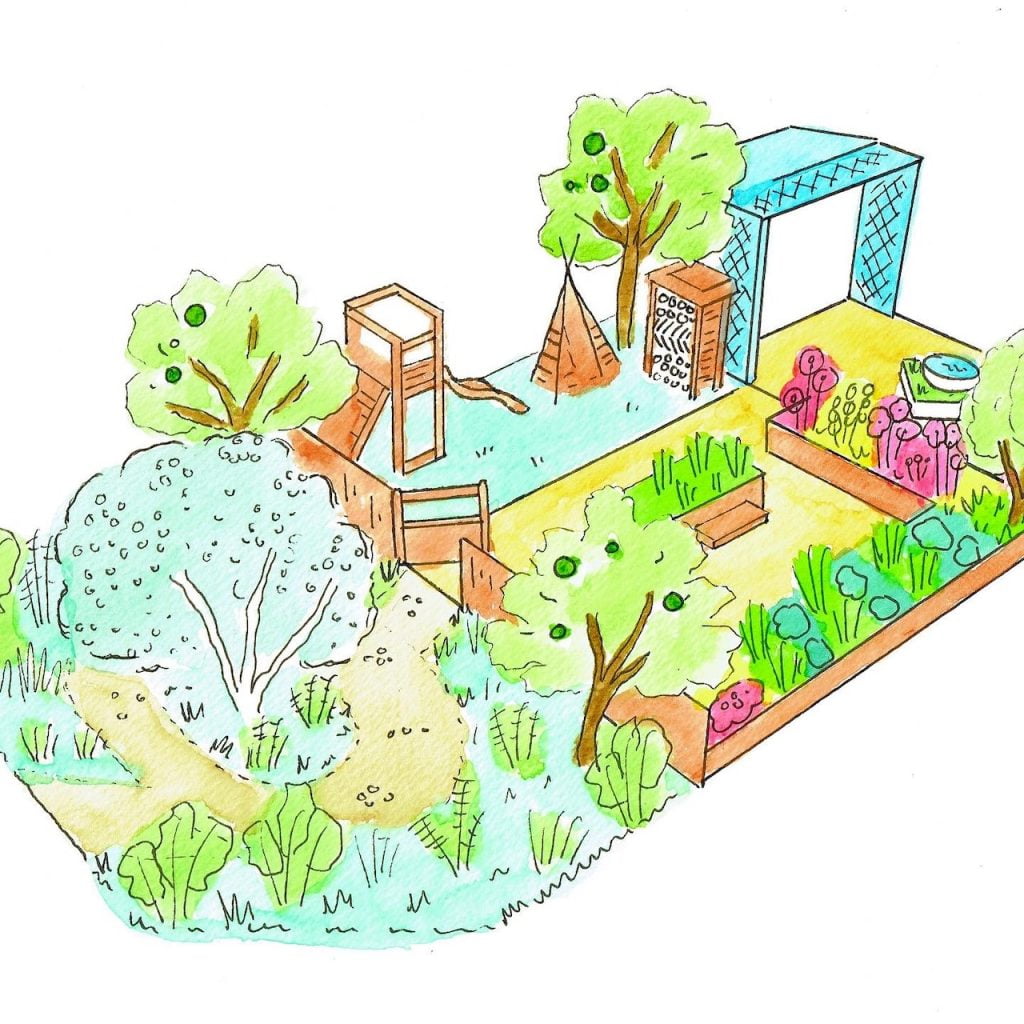
One of the best ways of encouraging children to use a garden is to use wild play. Natural materials such as logs, rope swings, and stepping stone paths encourage them to explore and make their own stories and integrate these within the garden design.
No garden is complete without a lush planting plan that really brings the area to life. Don't just think about lawns but use deep herbaceous borders to add interest, scent and interest for wildlife. Trees can bring height and attract birds, shrubs give winter structure and can help screen off play areas, and a rich herbaceous series of borders helps soften the transition between the zones.
Nothing will get your children out in the garden like a suitably home made bug hotel. They're super easy to make yourself; I've even got a guide here. Your children will love building this with you and it will help attract all sorts of amazing wildlife to your garden!
If there is one thing that children love to do in the garden, it is to grow plants from seed. Taking a few packets of seeds, whether vegetables or flowers and growing them with your children is a fantastic activity to help teach your children about the life cycle of plants and where their food comes from.
When it comes to design, why not factor in a cold frame, greenhouse or even just a simple potting table area where you and your children can grow your own plants? I guarantee you will both be hooked once you start!
Did you know that you can take my course and learn how to become a Garden Ninja yourself? Click here for details
If you've seen my other work on family-friendly garden design you will know how I love to zone off gardens. Zoning helps give a purpose to each space, whether it's the children's play area, the grow-your-own section or the relaxed adult chill-out area.
Garden zoning will help you easily design a space that has separate needs without it turning into a mishmash of flying footballs, prize flowers getting damaged or having to relax in the middle of a play area!
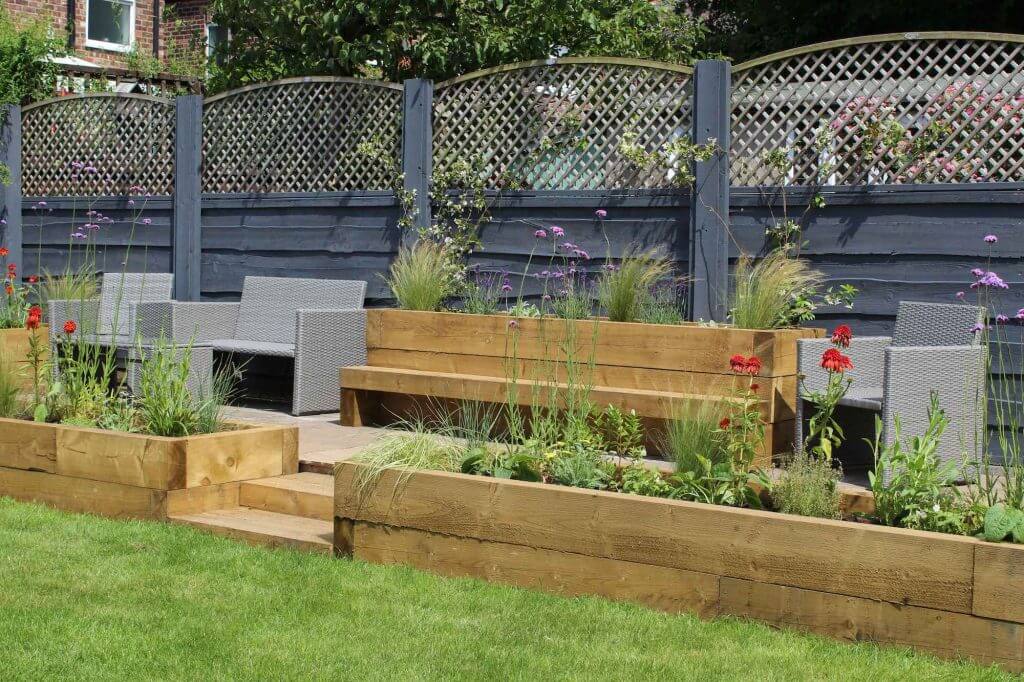
See how a small timber wall above separates the adult area from the main play lawn? Creating a clear marker between the two whilst allowing parents and children to interact. It also means that plants are protected from toys, and the adults sit in an elevated position where they can keep an eye on younger children.
The first thing I like to do is to plan exactly what type of materials I will use in a child-friendly garden to separate the zones and provide structure. Below is a list of materials often used and those to be avoided.
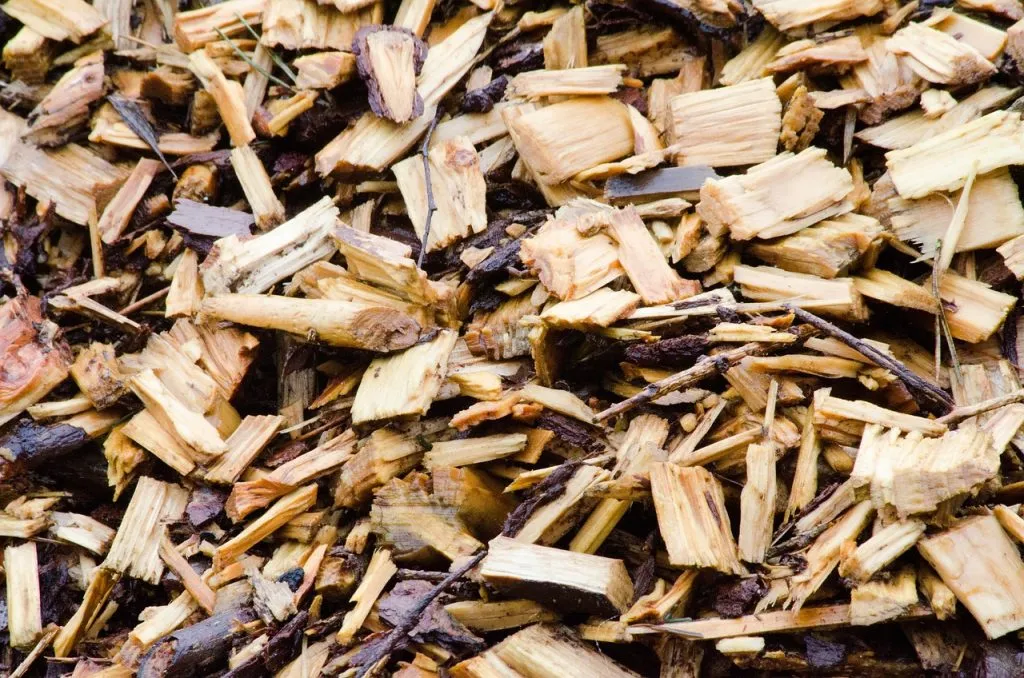
I find that timber sleepers are both multifunctional, safe enough and soft enough to blend a number of areas. When stacked two sleepers high, their height is tall enough for a toddler to be protected from the border but tall enough for a seat or perch for growing children and adults.
Walls are also suitable, but harder materials such as stone can provide a risk for children running into them or sharp edges.
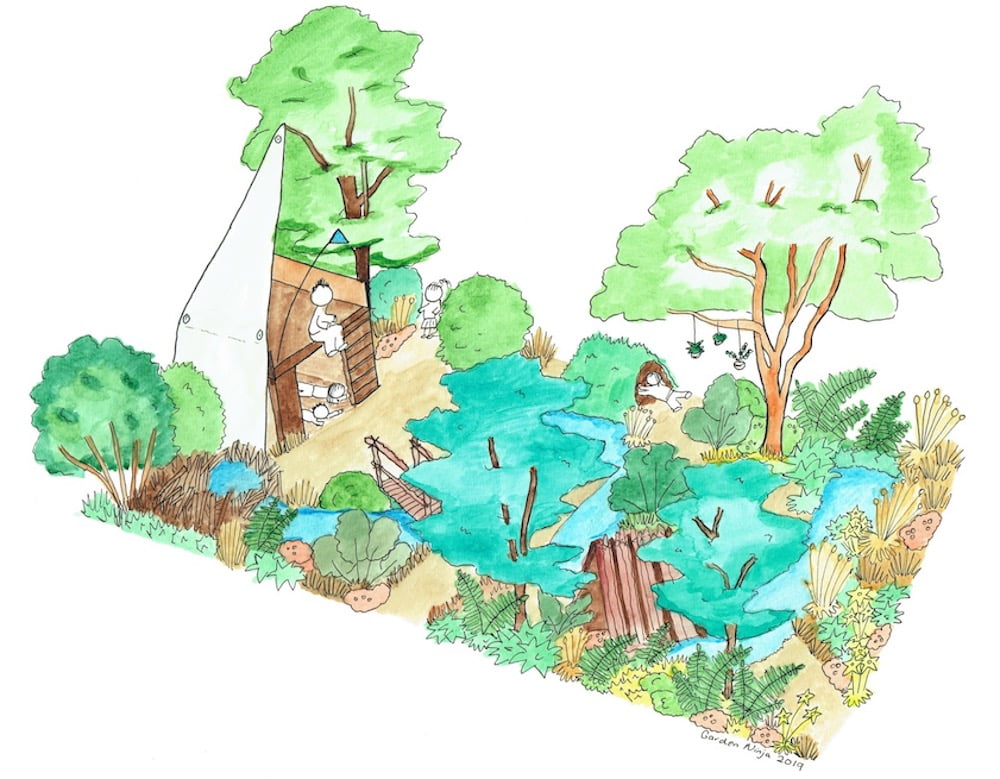
This woodland-themed children's garden features woodchip paths and natural materials running across a shallow pebble-filled stream.
Paving materials can be tricky. Often, parents worry that stone will provide a harsh surface for children to play on. Gravel is a much softer surface for any trips and falls but also leads to uneven areas for seating. Also, very young children have a habit of trying to eat small pieces of gravel!
In my experience, paving for paths and seating areas is the best option and turf or woodchip is used in play areas where falls and bumps are more likely. So, pick the material for the zone you're designing.
Artificial turf or plastic grass is often listed as an ideal child friendly garden material. However, I have a real aversion to artificial turf as it's probably the least child friendly and wildlife-suitable garden groundcover.
Artificial turf or fake grass has a huge environmental impact by covering our gardens with plastic matting that cannot be recycled.
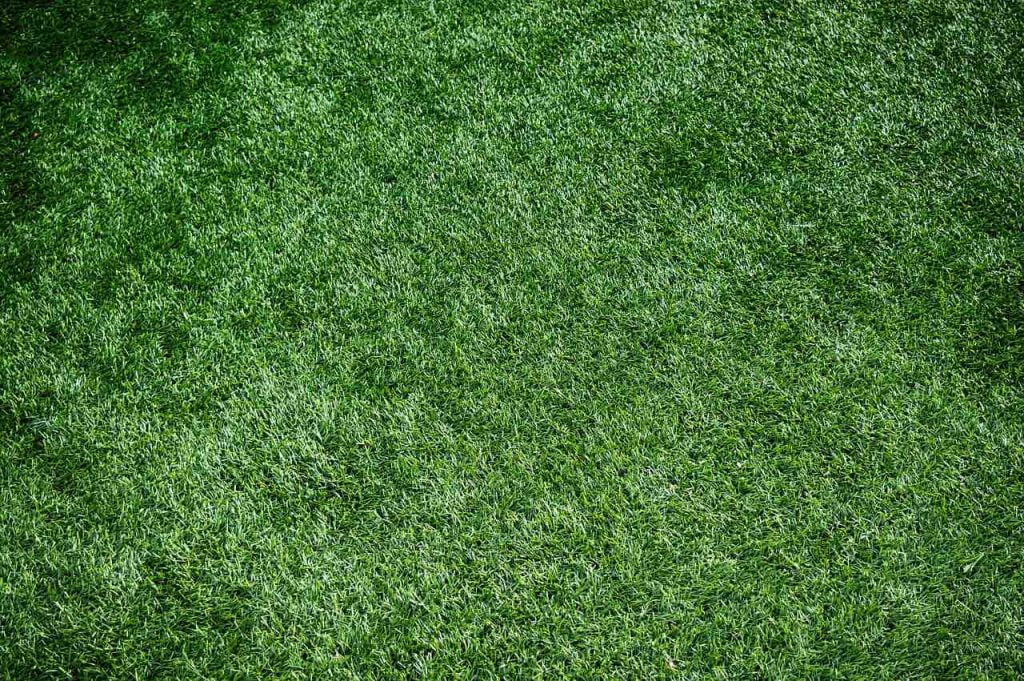
Artificial turf is not as low fuss as it may seem. It's not really maintenance-free. With artificial turf, you still need to brush it and treat it a bit like an outdoor carpet. It will need sand brushing in at least once a year. It also has a habit of floating up during heavy rain or floods.
If your dog wees on it, it won't turn yellow, but you have wet wee covered plastic instead that can smell awful in the summer. Water struggles to permeate through fake grass as this plastic matting is laid on top of compacted hardcore (rubble).
Lastly, I find it really unsuitable for children. Falling on turf may leave a grass stain on your knee, but falling on artificial turf leaves one heck of a friction burn at times. Rather than artificial turf, I would always advocate either real turf (it's barely more maintenance in reality), gravel or wood chip.
Most people are used to seeing a swing set or a massive jungle gym in a garden as the only way to keep children entertained. However, a better way to create entertainment is through more subtle approaches.
Why not create a path of cross-sections of logs like in the design below? These logs run through the borders, allowing children to use all garden areas. This way, children can hop and adventure through the garden borders. This doubles up as a route for playing a game of tick or musical statues.
The lawn below is edged so that there's a mini path around the lawn, so if it's wet, the children can avoid soggy grass. There are loads of tricks used in this garden to provide children with all sorts of play activities. Even the pergola walkway doubles up as monkey bars for older children!
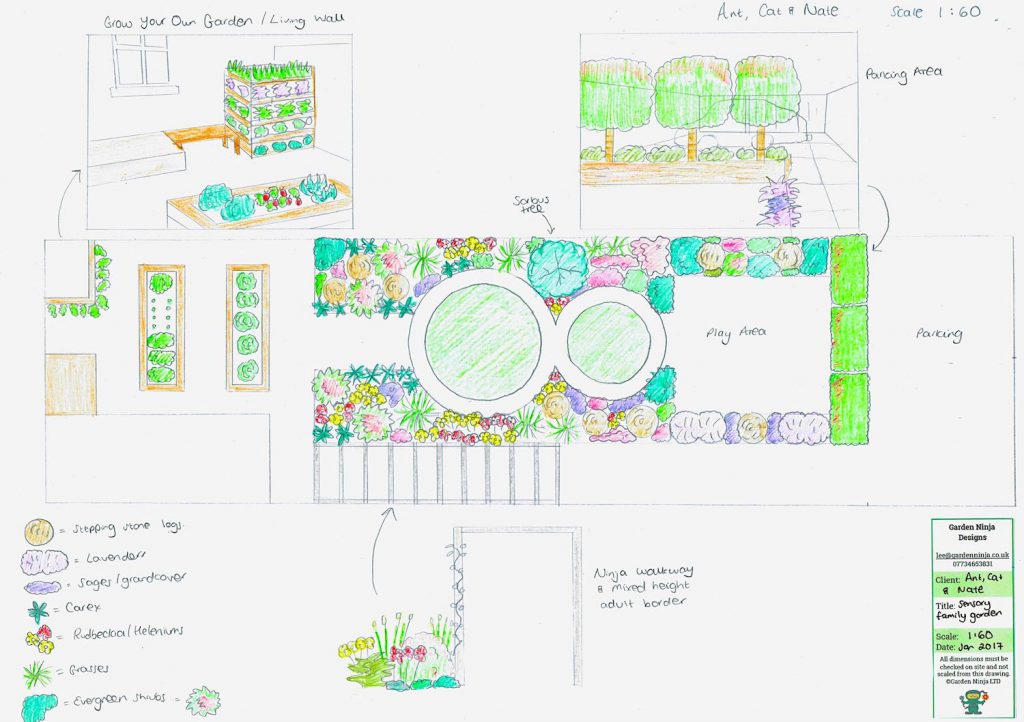
Rather than having a huge swing set, why not hang a rope from an existing tree with a tyre on it or use a rope swing? Then it's a swing, a seat and a secret spy window all in one!
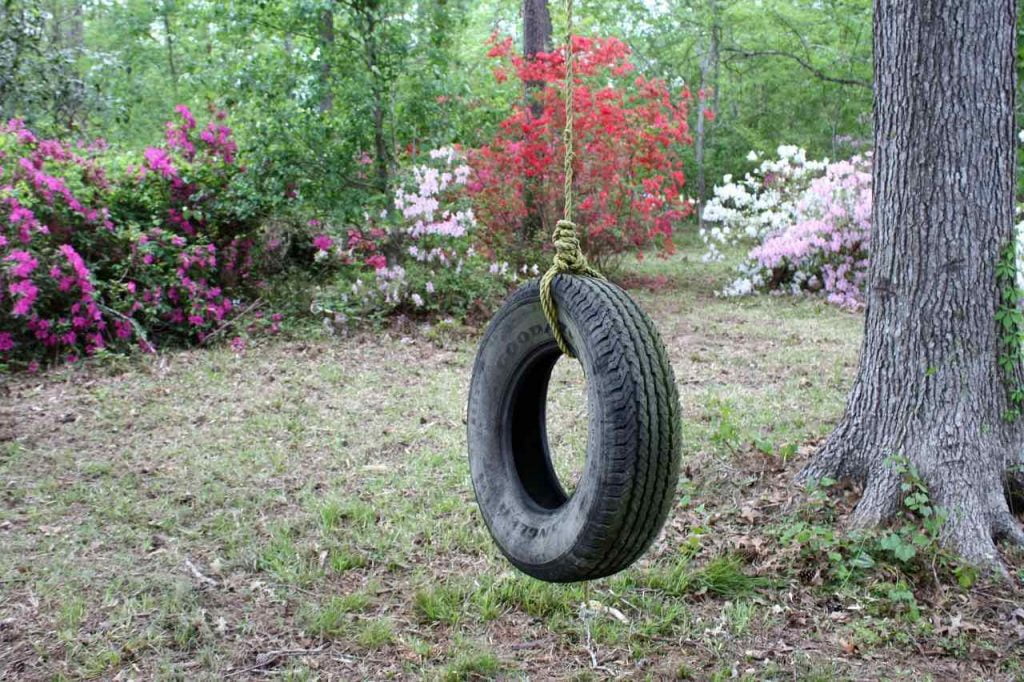
Instead of a Sandpit, why not have a grow-your-own box where children can plant vegetables and nurture their own plants?
Now that we have discussed the design, layout and zoning of a child-friendly garden, it is time for the fun part. The play equipment! The majority of shop bought play items are sadly made of plastic, most of which can't be recycled at the end of its life. I prefer to try and use more natural materials such as wood or recycled items.
When it comes to outdoor play equipment, children are not bothered by the most expensive shiny toys but by the play items that allow them the broadest category of fun! If you already have a very obvious play set that sticks out too much, why not use some of the ideas below to help it blend in? Camo nets and climbing plants can help soften large play structures and make them fit into your design far better.
So why not aim for multi-functional play areas such as the ones below?
These wooden adjustable swings can be attached to existing established trees or to the side of sturdy garden arches or frameworks. Always check the suitability of frameworks or tree branches that they are secure.
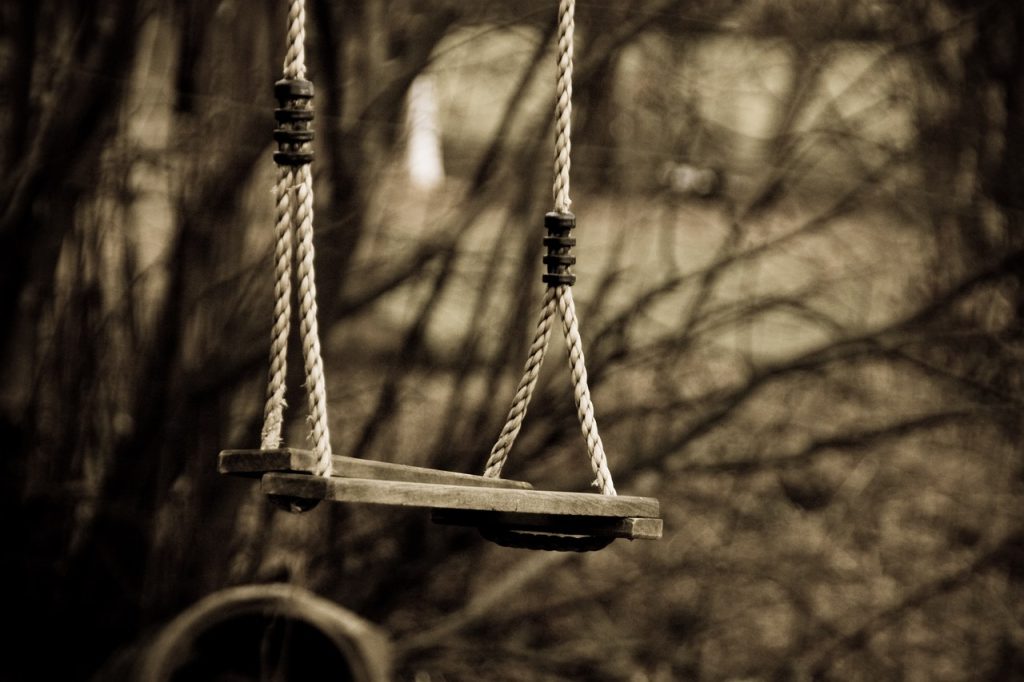
Dens are fantastic for children's wild play and relaxation. A den is a hideaway for children where they can play, read stories or relax away from their parents. All you need to do is create a box or frame that children can sit under or crawl into. You may even already have large trees with low branches that can act as the framework. Always make sure the framework is structurally sound and well connected as a builder if unsure.
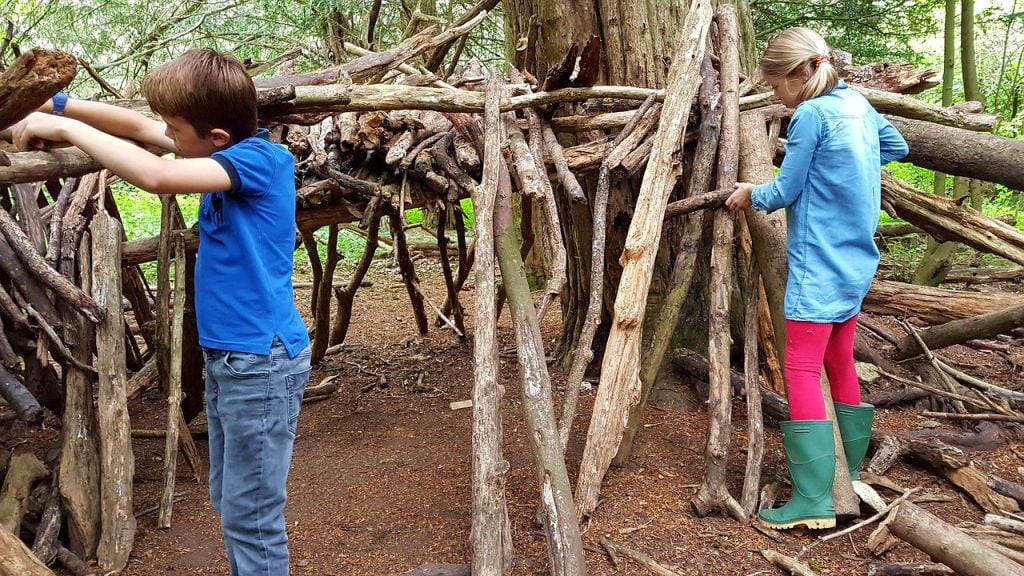
A den can be made from a simple fabric sheet laid over three or four pallets screwed together to make a box or even over some wooden supports. Easy to build in a weekend, and you can get the children involved too. Waterproof outdoor fabric like this makes an excellent cover for such a den!
Children love crawling through tunnels in gardens, whether a shop-bought fabric pop-up tunnel or one made from timber. I've used them in countless child garden designs. The beauty of a square timber tunnel is the top of it can be used as a makeshift table, and you can plant around it to make it blend in. Win-win!
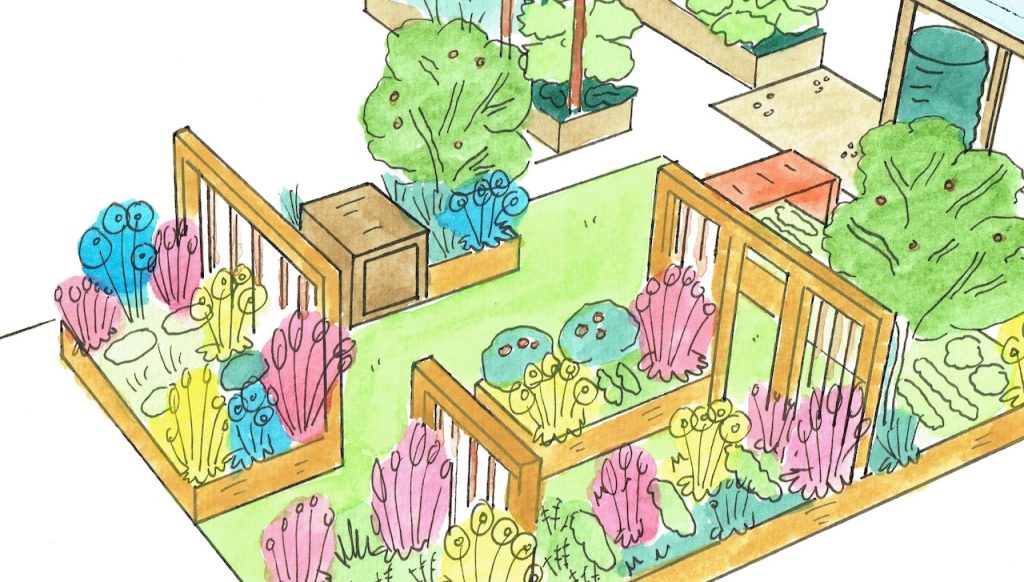
Can you spot the tunnel in the flower bed above and the bridge over the raised bed before the greenhouse? Well hidden, aren't they?
Now, this really is a bone of contention in the gardening world. Some people argue that you should never have any toxic plants in your garden, which makes sense at first. However, when you realise that most plants have some form of toxin or side effect if eaten or ingested, it makes you think again about plant selection. Unless you're going to fill your garden with lettuce, then you need to take a more balanced view to plant selection.
Now it goes without saying that super-toxic plants like Monks Hood, Lilly of the Valley and Euphorbia (the saps are highly irritant on the skin) should probably be avoided if children are around. However, even Hydrangeas (granny's garden favourites) contain cyanide and, if enough is eaten, are highly toxic.
The same is true with Foxgloves and other seemingly safe plants. Even Daffodil bulbs can be toxic if eaten. It's about being sensible and measured, teaching children about plants, not eating them unless you know they are edible, and treating them with respect. Even the humble Daffodil can be toxic if the bulb is eaten.
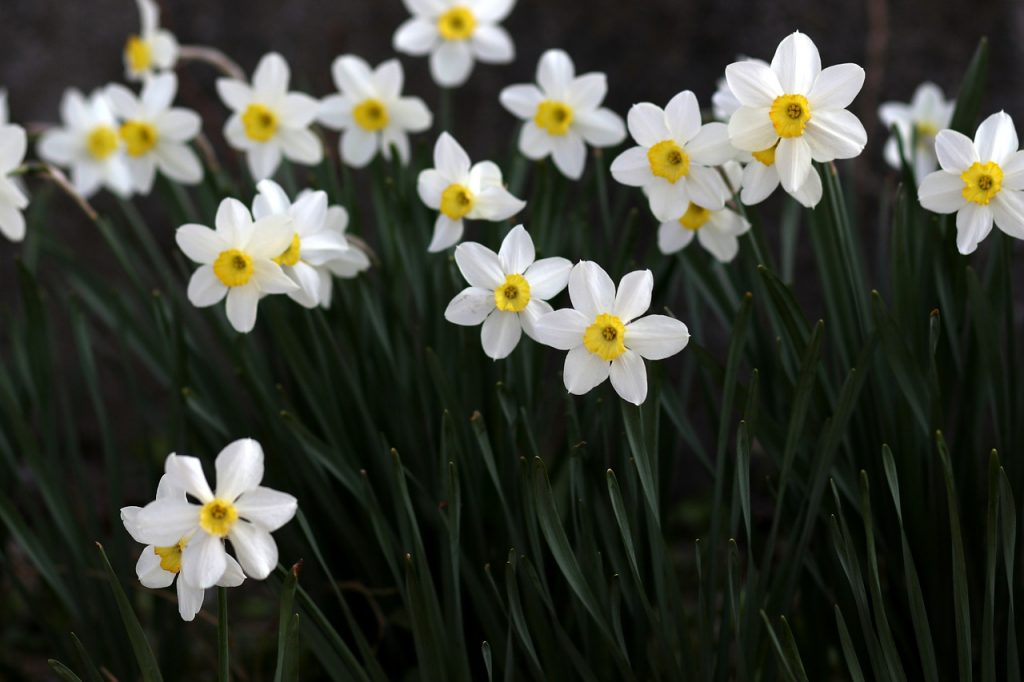
My argument here for child-friendly garden design is simple. If your children are likely to eat plants or be left unsupervised in the garden, you need to consider what plants you're putting in. In my experience, you supervise your children most of the time. Besides, children are more interested in climbing, hiding or collecting leaves than eating plants.
If you provide enough interest in the garden with play areas and activities, it should stop your children from resorting to eating plants and bulbs.
Here's a list of plants that, if you are concerned, you want to avoid in the garden. In particular, Monks Hood is the real nasty one in the group.
Also, whilst out in the woodland, make sure that you teach your children to avoid Giant Hogweed, often found in verges. It is huge, at least 7ft, if not taller. Its sap strips melatonin from the skin, causing blistering and years of skin damage as the skin then can't protect itself from the sun. If you see it, report it to your council for removal.
I have written extensively about the issues with new build gardens. Whether it be random grids, oddly shaped boundaries, wasted pockets of space or the fact you can't dig down further than an inch before hitting rubble, this garden was no exception. It was not a child-friendly garden at all.
A young working couple asked me to design their dream garden that was both child-friendly and sophisticated enough to entertain their friends and family outside. This article details the design and planting choices that Garden Ninja put forward.
The couple wanted to create a child-friendly garden that was also suitable for entertaining adults in. Space where children would be safe, but adults could feel relaxed with some privacy from neighbours. The garden's soil quality was terrible; they were overlooked and wanted a separate area away from the main garden to produce their own vegetables. I also had a challenge with a horribly damp corner, which I promised I would make into a feature for the children. Me and my big mouth!
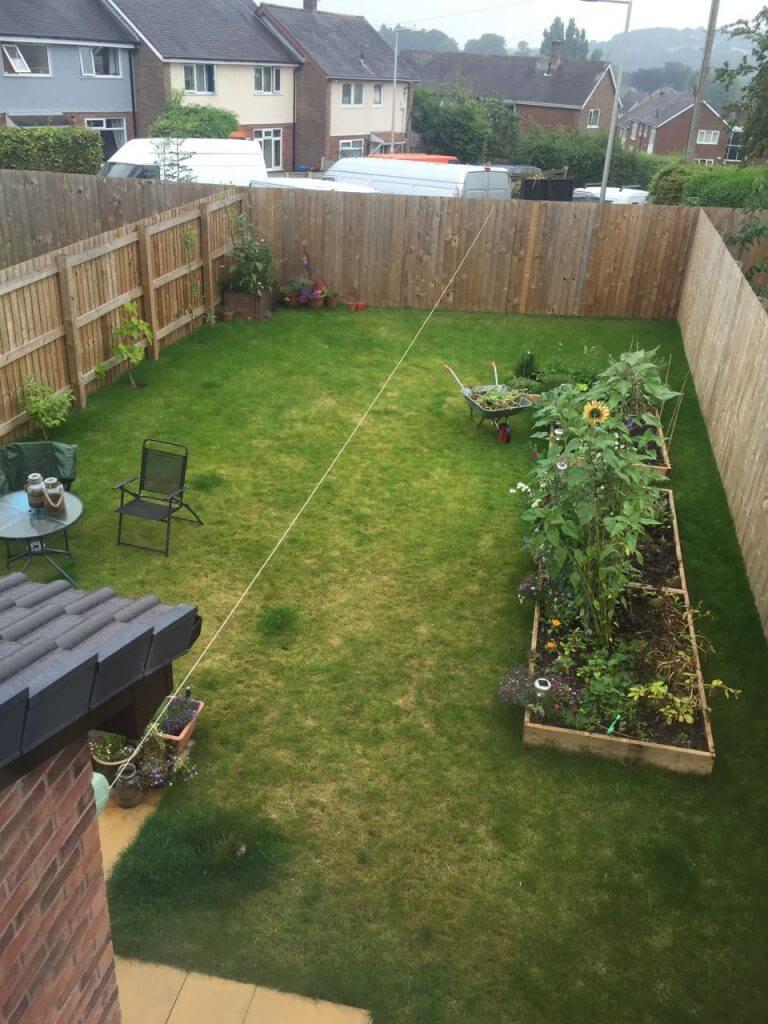
The first part of the design was to take the long garden and divide it into zones. Starting at the back of the garden, where the sun hit first, was perfect for the adult good life zone of the garden. The couple wanted a greenhouse, so I incorporated this into the plans in the adult zone.
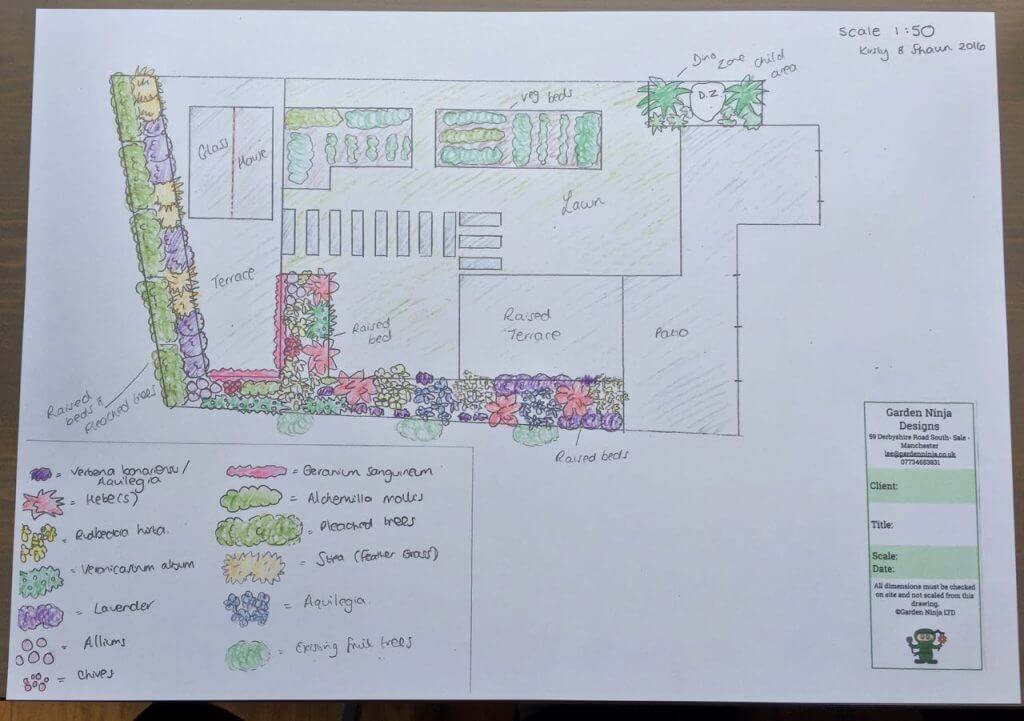
Using raised beds meant we could avoid mass excavation of the awful soil and bring in far better organic matter for the beds. The raised beds also help to screen off the zone from the rest of the garden. The clever use of pleached trees gives a contemporary screen to the back fence and some much-needed height to the child-friendly garden. They also wanted somewhere to sit in the garden.
The majority of the main garden was designed with child-friendly and edible plants. The raised beds gave a clear line between the borders so they could play safely. I kept this part relatively simple so children could kick a ball about it or put a slide there if they wished. When designing, it's important not to over-stylise a garden when children use it, as you risk making it too exclusive for adults. I chose the planting scheme full of tough and colourful child-friendly plants and could take the odd flying dinosaur or Barbie doll strop!
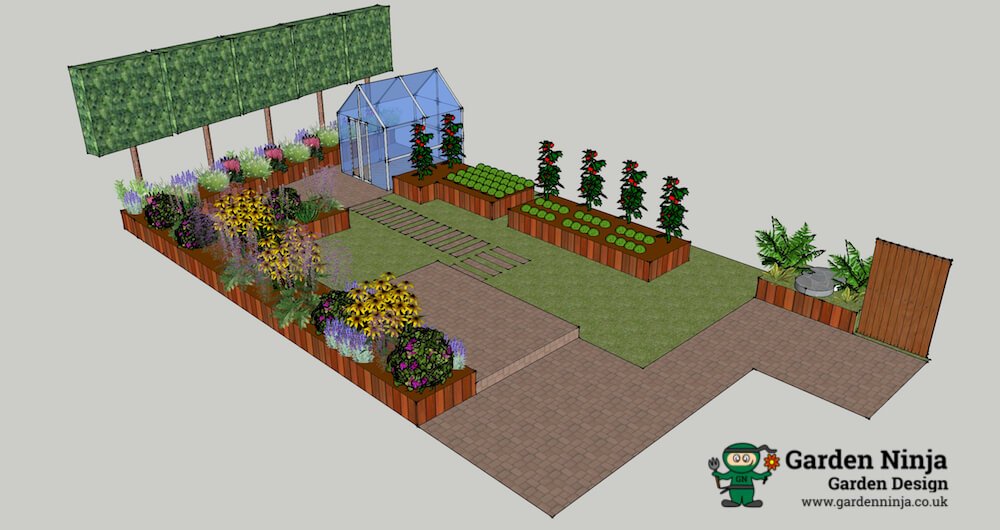
This area extended the current terrace, lifting it up a step that could be home to an outdoor dining space. Mirroring the width of the patio doors helped connect this area to the house and keep it scaled. I connected this to the adult zone via some stylised paving slabs that gave a contemporary stepping-stone look to the garden.
In the bottom right was a shady border that was quite damp; the design extended the path around the house to remove the now-dead turf. I also added another raised bed filled with ferns and shade-loving plants. It featured a giant flat rock that can be used as a children's play area to play with their toys.
Given that the couple's young child loved dinosaurs, I themed this as the Dino-zone! Even as the children grow up, this area will look good in its own right, with lush shade-loving plants full of texture and interest, but it makes for a really fun play feature, too.
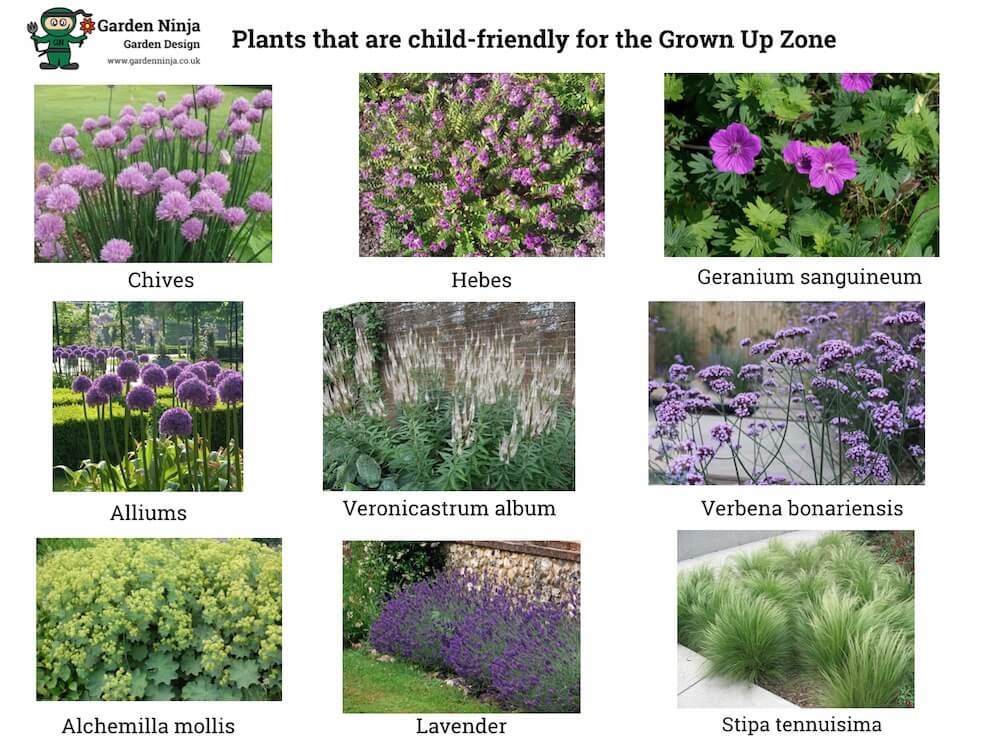
This design was a pleasure to work on. It was a real challenge given the limited space, the poor soil quality and the family's requirements, so it worked for adults and children. By using straight lines and zones and splitting the garden sensitively, I think the design really works for the couple. Even as the children grow up, the garden is 'adult' enough to morph into the next stage of their life.
Designing a child-friendly garden is relatively simple when you know how to! After reading this guide, you will now know about using zones in child-friendly gardens and carefully think about the purpose of each area of your garden. Yes, you can have a garden suitable for both children and adults that is still gorgeous once the children are grown up! With careful consideration, you can create a child-friendly garden that has space for playtime and relaxing without compromising.
Why not check out the other guides and vlogs on my YouTube channel? You can also check out my Tweet, Facebook or Instagram for more garden guides and tips. I'd love to hear about your own experiences of seed sowing and gardening without plastic, including the types of herbaceous plants you've grown from seed, so why not get in touch?


You must be logged in to post a comment.

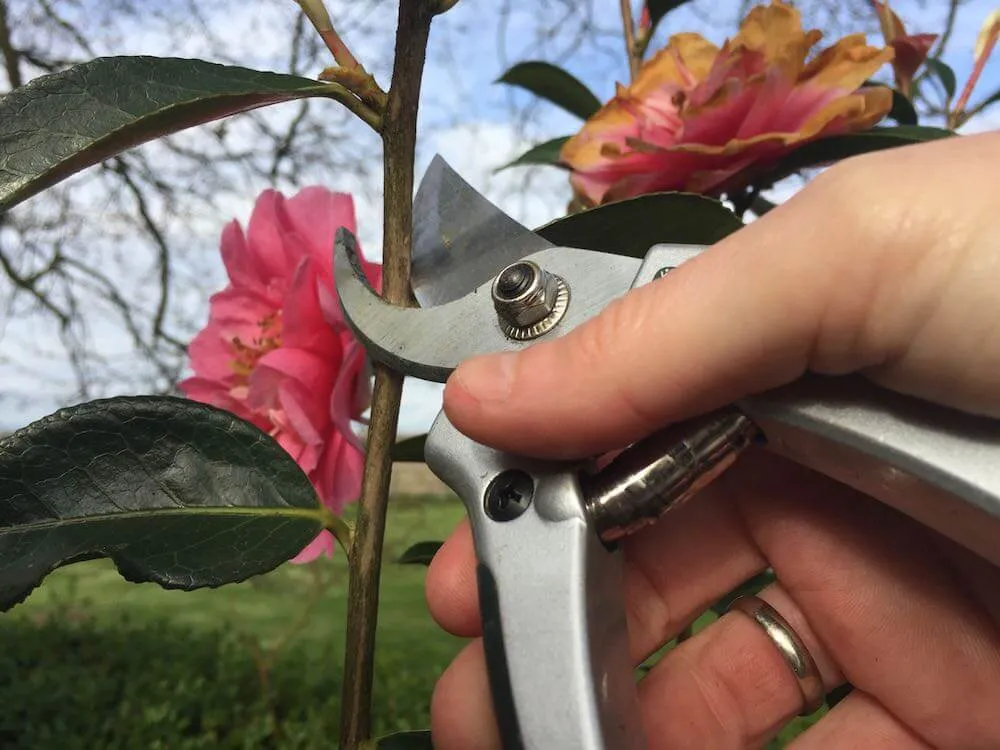

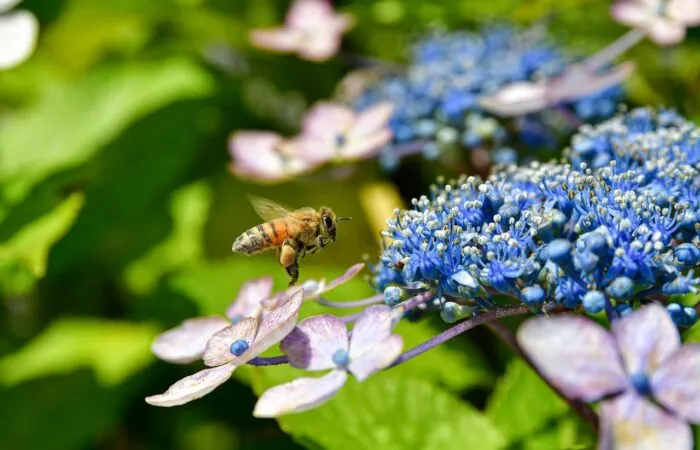
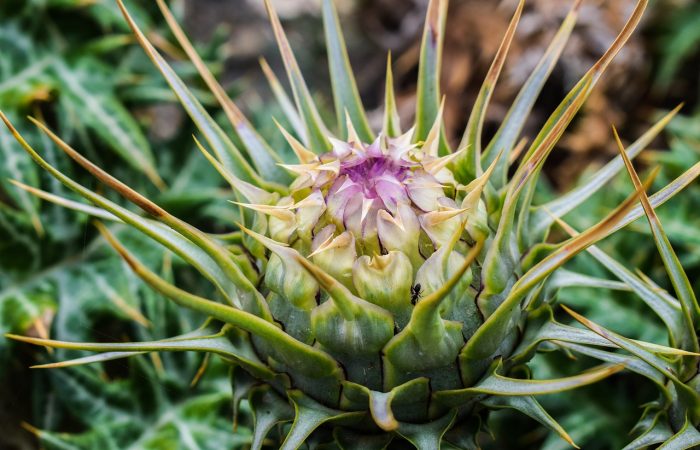

JOIN THE NINJAS

Be the first in line for new Guides, Discount codes and Offers
Hello Ninja!
Thanks for sharing, I really enjoyed your post here. We also have a new built and are looking to design our garden suitable for us and our little 16 month toddler. Do you have a picture of the finalised garden? I would love to see it.
Cheers
Peter
Hi Peter, Unfortunately I don’t have any after pics of this garden. The owners wanted to build it themselves in stages. Have a look at my Family Garden redesign though for a similar style.
Thanks Lee!